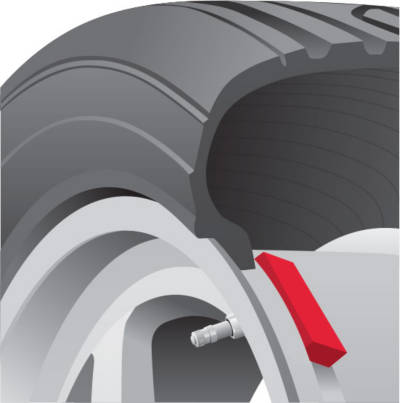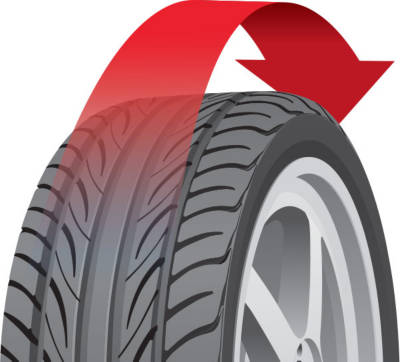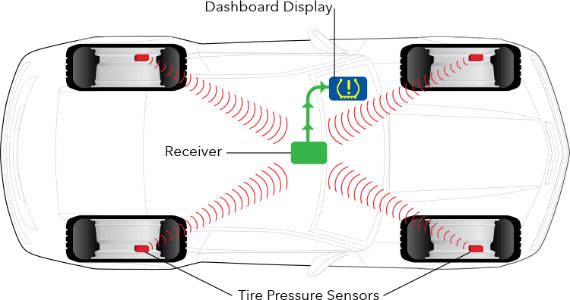A significant advantage to TPMS is the ability to prevent underinflated tires from growing into larger problems. Also, this system can help you address changes in outside temperatures that cause fluctuations in tire pressure. Promptly addressing air pressure issues can increase fuel efficiency, extend tire life and contribute to your vehicle's stability and safety.
If you see the TPMS alert on your vehicle's dashboard, immediately check your tire pressure or stop by one of our stores to air up your tires to the recommended pressure and examine your tires for damage, such as a puncture, to explain the air loss. If your alert is still displayed after setting the tire pressure, your TPMS may need to run through a "relearn" process or even require a TPMS sensor replacement.
Don't have TPMS on your vehicle? You can purchase retrofit kits to add a TPMS to a vehicle that was manufactured before they were standard equipment.
Direct and Indirect TPMS
There are two types of TPMS: direct and indirect. Each type uses different mechanical set-ups and methods to monitor tire pressure and alert you when it is low.
Direct TPMS measures air pressure through dedicated sensors attached to the wheel (rim). Indirect TPMS estimates low pressure based on tire rotation speed.
Direct TPMS
Direct TPMS uses battery-operated sensors attached inside the tire-wheel assembly to communicate with the vehicle. These sensors directly read the pressure in each tire and transmit data to the vehicle's computer. A dashboard light will be triggered if the tire's pressure drops below 25% of the vehicle manufacturer's recommended inflation reading. This gives direct TPMS a greater degree of accuracy than indirect TPMS. Some advanced direct systems even provide prompts to check individual tire pressures from the dashboard.
Direct TPMS systems have a variety of sensors that are each designed for your specific vehicle and trained to communicate with your onboard computer. The sensor is located inside the wheel and can be a variety of tire pressure sensor types, depending on your vehicle. Sometimes components can wear out and require TPMS sensors and rebuild kits.

Indirect TPMS
Indirect TPMS estimates an underinflated tire through wheel speed sensors used by the anti-lock brake system. These sensors measure the rotational speed of each tire. They can detect when one tire rotates faster than the others, meaning that the faster tire is low on pressure. You will see a highlighted alert on your dash if the system determines this to be the case.
Indirect TPMS was developed by automakers to comply with federal regulations while reducing vehicle costs. These systems are cheaper to produce because they utilize existing vehicle components however they have distinct disadvantages. An indirect TPMS cannot tell the driver which tire needs inflation. They also require calibration after any service including a tire change or air pressure adjustment to ensure system accuracy.

TPMS Sensor Batteries
TPMS batteries last approximately 6-10 years or 90-120,000 miles. Sensor replacement can become necessary due to tire sealant, corrosion from the elements and a weak or dead battery. The battery inside the TPMS is not removable. Therefore, when a TPMS battery dies, a new sensor is required. The TPMS sensor should be installed by a tire professional so that the system can be trained to recognize the new sensor.
If one battery has died, it is likely the others are very close to needing replacement too. It may be a good time to replace all of your sensors to eliminate any other TPMS-related issues shortly down the line.

TPMS and Air Pressure Checks
Although TPMS provides valuable feedback in monitoring your tire pressure it should not replace monthly air pressure checks. Both types of TPMS only alert when the tire pressure drops below the recommended reading by 25%. This is a high threshold as tires that are underinflated by just 5% begin to suffer from decreased fuel economy and increased internal temperatures. These issues become more pronounced as underinflation increases so your tires can actually be underinflated without triggering a TPMS alert.
For this reason, you should never rely solely on TPMS to monitor your tire pressure. Always use a reliable gauge to manually check it each month. The TPMS functions as a warning that complements an existing safety routine and is not a first line of defense.
America's Tire offers complimentary tire air pressure checks to give you peace of mind. If we see anything wrong, we are prepared to help you handle it with our suite of tire services!
If you have any questions or need any assistance, stop by your local America's Tire and we'll get you taken care of.
